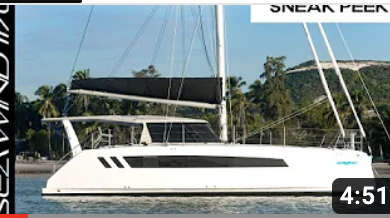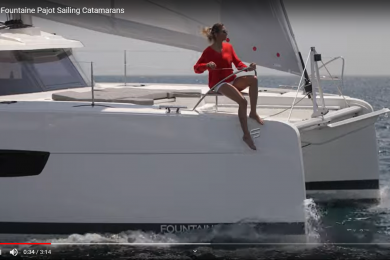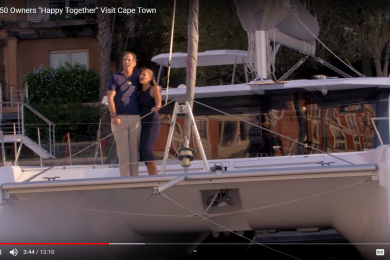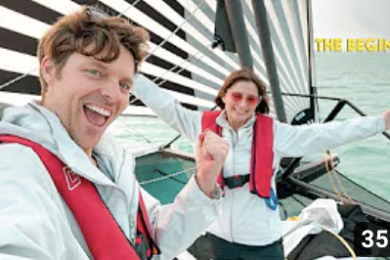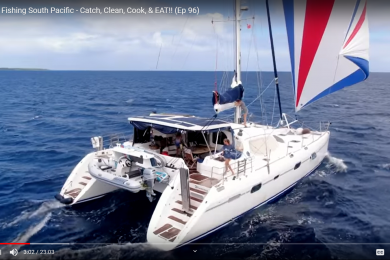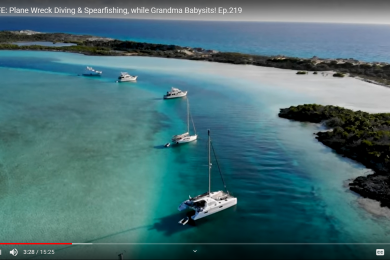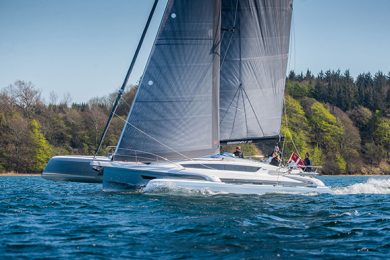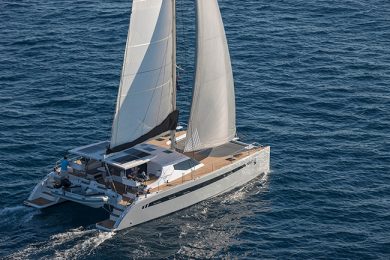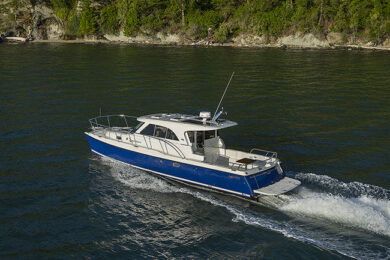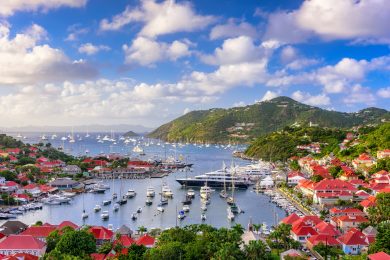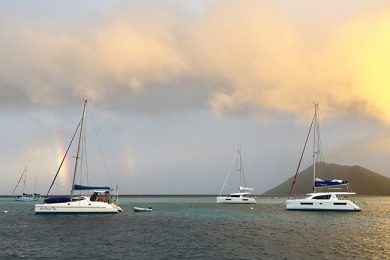
A New England family sails through the centuries on the Turquoise Coast (Published Fall 2011)
Turkey’s Turquoise Coast enjoys a reputation for brilliant blue waters, warm sun and a picturesque coastline scattered with ancient ruins. Turks have long acknowledged its attractions, commuting in droves to the south coast during vacations. Foreigners, too, have begun to recognize the appeal of the Turkish waters, and as a result it is now easy to arrange a bareboat charter in the region. The opportunity to explore new cruising grounds aboard a Sunsail 384, the charter version of the Leopard 38 built by Robertson and Caine in South Africa, was provided by Sunsail’s Gocek charter base.
My New England-based travel companions included my parents, my aunt and my uncle. Getting from Boston to Gocek was an adventure of its own. If the cost of airfare is a concern, the route is long and circuitous. Our path took us through Manchester, England, where we flew in at 8am and left at 10pm. This gave us a day to explore the city, and guaranteed that when we flew from Manchester to Dalaman (the closest airport to the charter base in Gocek—about a 30-minute drive), landing at 3am, we were seriously jet-lagged. Small, sleepy Mediterranean coastal towns aren’t exactly filled with 24-hour hotels, so plan your arrival time accordingly. We passed the hours until daylight on some outdoor furniture at the bar located next to the charter base.
Gocek enjoys a healthy yachting community due to its protected location at the end of Fethiye Bay. Provisioning is easy; there is a small market just across the street from the Sunsail base, and fresh fruits and veggies are just a 10-minute walk away at the farmers’ market in town. There is also a plethora of restaurants lining the waterfront, all boasting identical menus. We chose at random, sitting down to what would be the first of many meals of kebab and meze.
Gocek is a vacation destination for both foreign and Turkish tourists and features a main strip filled with marine stores and small boutiques. My aunt, who carefully planned on spending her shopping time and dollars at the Grand Bazaar in Istanbul, where we were headed upon the conclusion of our charter, succeeded in buying some silk carpets the very first day we were there. Once the rug dealer offered us apple tea (surprisingly delicious) and we accepted, there was no going back. We spent the week sailing with fine carpets tucked in the front of one of the V-berths.
GULETS GALORE
Sunsail plans for a Friday evening arrival for charterers. Your boat is ready by 6pm and you stay on board at the marina in Gocek Friday night, casting off in the morning. We were the second boat off the dock on Saturday, just ahead of a 38-boat rush. We pushed hard the first day, making it a grand total of about five miles through protected Skopea Limani (Gocek Bay) before we made our first stop for a swim. This whole region has been designated an environmentally-sensitive area by the Turkish government, entailing a modification to the standard method of mooring throughout Turkey. Normally, a visiting yacht drops its anchor (nearly every boat we saw had all-chain rode, which comes in handy, as it can be difficult to set normal amounts of scope due to the water’s depth) and runs a stern line to a convenient rock or tree ashore. Within the protected areas, however, the Turkish government has securely fixed orange-painted bollards to the coastline. We were cautioned that failure to use the bollards would result in heavy fines. This may have been a situation where there are different rules for locals and foreigners, because while all the bareboat charterers used the bollards, the ubiquitous gulets moored wherever they saw fit. We chose not to test the Turkish water police, and there were always plenty of bollards to be found while we were sailing through Fethiye Bay.
While we were enjoying the very warm water, a boat loaded with provisions from a market in Gocek came by, ready to sell whatever we needed. While we were fully provisioned, it was nice to learn that if we should run out of Efes beer, a ready supply would be near. After hauling anchor we continued on our way, briefly poking our nose into Wall Bay, a small harbor to the southwest of Gocek on our way out of Fethiye Bay.
We motored with the mainsail up through a narrow cut and rounded the peninsula marking the western edge of Fethiye Bay. Our destination the second day was the ruins at Dalyan, about 30 miles from Gocek, so we wanted to take a few miles off the passage. We chose a small harbor at random and attempted to set anchor, but due to the steep drop-off we could not get the anchor to hold properly. Fortunately, harbors are close and numerous, so we simply motored to the next one and spent the night stern-to the shore, in the company of a few other charter and private boats.
Throughout the evening, gulets—twin-masted traditional wooden Turkish vessels—continued to arrive, dropping yachtsman’s anchors and reversing at warp speed toward the shoreline. We were starting our cruise at the beginning of Ramadan. Apparently, many Turks use this time for their own vacations, journeying to the south coast and hiring gulets to take them to the same harbors and destinations we were headed to for swimming, sightseeing and al fresco dining. The number of gulets was incredible—they seemed to materialize from over the horizon in a never-ending stream.
COFFEE AND CLOGS
After spending the first of many nights sleeping on deck, we awoke early for our “long” 25-mile passage to Dalyan, renowned for its ancient Lycian tombs, the ruined city of Kaunos and a large sandy beach. The town is located up a river, inaccessible to cruising boats, so we followed Sunsail’s recommendation to moor in nearby Ekincik and hire a guide to take us in a small boat to Dalyan proper. Our journey to Ekincik was the longest single passage of our cruise. We’ve never spent so much time covering so few miles, but due to the vast number of harbors, towns and ruins to explore in such a small area, we certainly didn’t feel as if we had been slacking.
We also discovered the wrong way to drink Turkish coffee. The boat came with a French press, and we had picked up a box of coffee grounds. Turns out Turkish coffee is a bit stronger than what we’re used to in the U.S. My uncle Dana didn’t take too well to the mud that came out of the press and spent the passage toward Ekincik hanging over the lifelines. The crew drank tea for the rest of the time aboard.
We moored on the dock at Ekincik, picking up mooring lines attached to concrete blocks on the bottom rather than setting our own anchor. Many harbors in the area are run in a similar fashion. A restaurant either has a few moorings or a dock, and instead of anchoring, cruisers customarily take advantage of the service. As a quid pro quo, you then dine at the restaurant, with no additional dockage fee.

Ekincik was gorgeous. It was swankier than most of the other harbors we visited, and had a very small market for essentials as well as a beautifully laid-out restaurant and marina. The heads were a short walk up a very steep hill from the boat—shoes were essential. Upon reaching the head, however, you took off your sandals and slipped on a pair of wooden clogs, replacing them in the rack at the door.
KEEPING WATCH
It was not difficult to hire a boat to take us to Dalyan. It’s quite common for cruisers to moor in Ekincik, so the local guides regularly motor through to see if anyone wants a lift. We hired a small boat that took us the hour to the mouth of the Dalyan River. There, our guide skillfully maneuvered through the sandbars and began winding up the river. One boat of tourists hadn’t been quite so fortunate and was stuck hard aground, just outside the channel. The well-known Iztuzu beach was filled with vacationers, but we chose to forgo beach time (and the mud baths) for an opportunity to wander through Kaunos. As we entered the river, we paused alongside another small boat where a man was baiting enormous loggerhead turtles, which would rise out of the water to snatch a snack from his hand.

Kaunos was an ancient port city founded during the Lycian era. It’s now an archaeological site, which meant that my mother, a former archeology student, couldn’t pass up the opportunity to stare at really old rocks. Our guide dropped us on a dock at the foot of the hill where the city is located, and we spent a few lira to hire a tractor to take us to the top. The walk uphill is short, but the triple-degree heat left us sweating even while sitting still. Kaunos is still an active dig, so we got to watch the archeologists at work. It’s an impressive view from the top of the ruins, down the river and over the beach toward the ocean. Equally impressive are the acoustics in the amphitheater on site, where we were serenaded by a French family on vacation.
As we continued up the river toward Dalyan for lunch, the Lycian tombs came into view. These ornate facades were carved into the cliffs overlooking the river—an amazing feat of engineering from over 2000 years ago. Throughout our time in Turkey we would stumble across some of these tombs, but none were as impressive as the ones keeping watch over Dalyan.
TRAPPINGS OF CIVILIZATION
From Ekincik, we turned back toward the east. Our next stop was Bestas Limani (Cold Water Bay). This tiny harbor gets its name from the underground springs that feed chilled water into the warm Mediterranean. A couple of our party experienced the springs firsthand, swimming from the ubiquitous restaurant back to the boat after a hike. The harbor had warm patches interspersed with much more “refreshing” waters. Our meal that evening, while not the best food, certainly boasted the most fantastic view, as we sat on the edge of a bluff overlooking the moored boats in the harbor many stories below.


A three-and-a-half-mile hike from the restaurant leads to Kayakoy, an abandoned Greek village. The village was founded many centuries ago and housed a Greek community until that country’s struggle with Turkey in the early 1920s. As part of a population exchange, the Greek population was sent back to Greece in 1922. It has since been left as a ghostly museum, and strolling through long-abandoned streets past crumbling houses creates a very eerie feeling. Adding to the surreal experience is the current Turkish town, settled in the valley below.

After days spent in quiet, secluded harbors, some in the crew were ready for more populated territory. So we kept traveling east back across Fethiye Bay, toward the city of Fethiye itself. This is a larger town, with the accompanying noise, traffic and crowds. Fethiye was the one place where we couldn’t see the bottom of the harbor and didn’t have any desire to swim in the water. Fortunately, the marina (the only one on our journey where we had to pay for dockage) had a pool and cold beer.

We did have one of our more colorful interactions in Fethiye. We had heard the call to prayer emanating from the mosques’ minarets whenever we were near a town, but none of us had ever been inside a mosque. A man cleaning the yard surrounding one invited us in for a tour, reassuring us that there was no fee. However, that claim apparently only applied to entering the mosque itself—he was more than happy to charge a guide fee for the brief tour. When we later got a tour of the Blue Mosque in Istanbul, our guide laughed when we told him this story. Apparently this is a good way to make some extra money from unsuspecting tourists.
GÜLE GÜLE
We had one night remaining for our one-week charter when we left Fethiye the next morning. Sunsail requests that all boats be back Friday afternoon so they have enough time to send the cleaning crew aboard before the next charterers pick up their boat that evening. We decided to spend the night in Wall Bay, which we had briefly motored through on our first day out.

On our way back, we finally had the breeze we needed in order to put the catamaran through its paces. Winds had generally remained light, and the spacious accommodations and generous deck space meant that the Leopard required more than zephyrs to maintain pace. The set-up on board was ideal for cruising; all sail controls led back to the helm, so while the helmsman had plenty of pulling to do, the rest of us could remain focused on our tans. The four staterooms and twin heads were certainly more than our group needed, as the forward net and cockpit benches proved to be the bunks of choice.
After passing a final night at Wall Bay and racing up the slope of one more mountain, it was time to return to Gocek. The pier next to the Sunsail base has a fuel truck and pump out station; upon entering the harbor, we were pumped out and fueled up with amazing alacrity. Then it was time to leave the boat at the base and take our cab back to the Dalaman airport. The Sunsail staff made the logistics as painless as possible. Just as they had dug up towels for us to use when we arrived before the boat was ready, they had a cab waiting to get us on our way. As we left, the next group of vacationers was walking down the dock, ready for their own discovery of the Turquoise Coast.
Josh grew up sailing on Narragansett Bay. As a child, he enjoyed cruising with his brother and parents throughout New England and racing dinghies locally. He continued competing throughout high school and college, and now lives in New Orleans, LA, where he races his Vanguard 15 and travels for as much ocean racing as he can.
